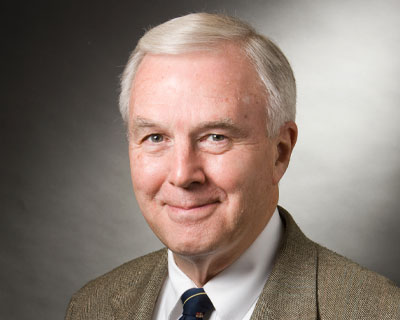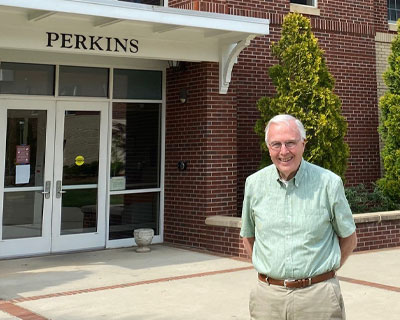After four years as the editor of Scope, M. Bruce Shields, MD, is stepping down. The new editor, Alfredo Sadun, MD, PhD, has invited me to contribute a few words about Bruce.
As is true for most Academy member positions, Bruce’s editorship has been an uncompensated labor of love. At Scope, I collaborated with Bruce for a time as an associate editor. This was but the last of many previous productive and pleasant associations.
Bruce came to Duke University as a resident in ophthalmology in 1970. Very few can say that they taught Bruce anything about glaucoma that he did not already know. But as a faculty member teaching this new resident, that was my privilege. After a fellowship in glaucoma at the Massachusetts Eye and Ear Infirmary, spending time with such luminaries as Paul Chandler, MD and Morton Grant, MD, he returned to Duke in 1974 to run their glaucoma service. Soon he was teaching me. Bruce wrote his classic Textbook of Glaucoma on a writing retreat after being urged by our chief, Robert Machemer, MD. It was a succès fou (extraordinary success) and is now in its seventh edition with translations into five languages. This is just one of several books and over 100 papers that Bruce authored. For many years, scanning the journals for Bruce’s latest would almost always turn up another gem of a Bruce Shields’ paper.

M. Bruce Shields, MD
The trio of Bruce in glaucoma and Drs. Carol and Jerry Shields in tumors was so prolific that the Shields name seemed to appear monthly. Differentiating which Shields was writing didn’t really matter because all of their papers were instructive contributions.
Bruce left Duke in 1996 to become a faculty member and chairman of the Yale Department of Ophthalmology and served in that capacity until 2011. He continued to contribute to the educational programs of the Academy receiving the Lifetime Achievement Award in 2008. He was a guest of honor in 2014. However, his work as an educator extends far beyond his work with the Academy and Yale.
Bruce has given 46 named lectures and served as a visiting professor for more than 50 university programs. He has presented at over 150 major U.S. meetings and 34 abroad. His leadership roles have included chair of the American Board of Ophthalmology and President of the American Glaucoma Society, among others. While at Duke he received the Davison Award for teaching excellence and earned a similar honor from Yale. In fact, the award at Yale now bears his name.
As these awards indicate, residents appreciated the time he took to teach and his gentleness in handling their missteps. Bruce was a masterful teacher who used the Socratic method to inspire as well as inform his residents. At Duke, he earned the sobriquet of “Mr. Rogers,” reflecting his calm demeanor. Some readers may remember this title character of children’s television known for his gentle wisdom. Many people still see today, though they know not that their vision was saved because of his students who were made better by the teachings of Bruce Shields.
Upon retiring from Yale and returning to North Carolina, Bruce again volunteered his services to residents at Duke. Before COVID-19, he would drive weekly from his new home in Burlington, N.C., to Durham, N.C., to teach and to participate in grand rounds. Bruce has published stories from his ophthalmology practice in a volume titled Gifts of Sight. It is an uplifting read. He brought to Scope his expertise in editing and writing. He also brought gentle care and concern for Academy staff and for his authors. From all of your many writers and readers, Bruce, our heartfelt thanks.

Bruce pictured at Elon University and this beautiful dormitory named in honor of his wife, Nan.
Alfredo A. Sadun, MD, PhD: On a Personal Note
I became friends with Bruce, having shared with him many committees and assignments on the American Board of Ophthalmology or American Academy of Ophthalmology.
I knew him to be a warm and kind gentleman and scholar. About 1996, I took on a challenge from my chairman, Steve Ryan, MD, to get more applicants into the Doheny residency program from the Ivy Leagues. I had trained at Harvard and might expect a kind reception there. But where else could I go with my plan to identify and solicit the best medical students?
I asked my trusted friend, Bruce. He helped me organize a yearly visit to Yale that included a neuro-ophthalmology lecture following grand rounds in his department. He also urged me to give a general lecture to the medical school which would hopefully make a good impression on the academically minded medical students. And for this purpose, he suggested I expand on some broad and attractive topics we had discussed over our many dinners together.
So, topics as varied as the psychophysics of the French impressionists and conversations with Castro emerged. Every year, I thought long and hard on what would capture the imaginations of the best medical students and win Bruce’s admiration. Dinners with the Yale medical students led to new friendships and Doheny residents. But also, each year Bruce invited me to dinner at the Jonathan Edwards residential college at Yale, where Bruce’s very intellectual friends became my friends. I basked in his reflected goodwill.